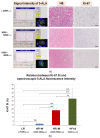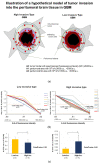Identification of CD44 as a Reliable Biomarker for Glioblastoma Invasion: Based on Magnetic Resonance Imaging and Spectroscopic Analysis of 5-Aminolevulinic Acid Fluorescence
- PMID: 37760811
- PMCID: PMC10525185
- DOI: 10.3390/biomedicines11092369
Identification of CD44 as a Reliable Biomarker for Glioblastoma Invasion: Based on Magnetic Resonance Imaging and Spectroscopic Analysis of 5-Aminolevulinic Acid Fluorescence
Abstract
Recurrent glioblastoma multiforme (GBM) is largely attributed to peritumoral infiltration of tumor cells. As higher CD44 expression in the tumor periphery correlates with higher risk of GBM invasion, the present study analyzed the relationship between CD44 expression and magnetic resonance imaging (MRI)-based invasiveness of GBM on a large scale. We also quantitatively evaluated GBM invasion using 5-aminolevulinic acid (5-ALA) spectroscopy to investigate the relationship between CD44 expression and tumor invasiveness as evaluated by intraoperative 5-ALA intensity. Based on MRI, GBM was classified as high-invasive type in 28 patients and low-invasive type in 22 patients. High-invasive type expressed CD44 at a significantly higher level than low-invasive type and was associated with worse survival. To quantitatively analyze GBM invasiveness, the relationship between tumor density in the peritumoral area and the spectroscopic intensity of 5-ALA was investigated. Spectroscopy showed that the 5-ALA intensity of infiltrating tumor cells correlated with tumor density as represented by the Ki-67 staining index. No significant correlation between CD44 and degree of 5-ALA-based invasiveness of GBM was found, but invasiveness of GBM as evaluated by 5-ALA matched the classification from MRI in all except one case, indicating that CD44 expression at the GBM periphery could provide a reliable biomarker for invasiveness in GBM.
Keywords: 5-aminolevulinic acid; CD44; biomarker; fluorescence spectroscopy; glioblastoma; glioma stem cell; invasion.
Conflict of interest statement
The authors declare that there are no conflict of interest regarding the publication of this paper. None of the authors has any financial interest in this work.
Figures








Similar articles
-
Prediction of Glioma Stemlike Cell Infiltration in the Non-Contrast-Enhancing Area by Quantitative Measurement of Lactate on Magnetic Resonance Spectroscopy in Glioblastoma.World Neurosurg. 2021 Sep;153:e76-e95. doi: 10.1016/j.wneu.2021.06.044. Epub 2021 Jun 16. World Neurosurg. 2021. PMID: 34144167
-
A prospective Phase II clinical trial of 5-aminolevulinic acid to assess the correlation of intraoperative fluorescence intensity and degree of histologic cellularity during resection of high-grade gliomas.J Neurosurg. 2016 May;124(5):1300-9. doi: 10.3171/2015.5.JNS1577. Epub 2015 Nov 6. J Neurosurg. 2016. PMID: 26544781 Clinical Trial.
-
Systematic histopathological analysis of different 5-aminolevulinic acid-induced fluorescence levels in newly diagnosed glioblastomas.J Neurosurg. 2018 Aug;129(2):341-353. doi: 10.3171/2017.4.JNS162991. Epub 2017 Oct 27. J Neurosurg. 2018. PMID: 29076783
-
5-Aminolevulinic Acid False-Positive Rates in Newly Diagnosed and Recurrent Glioblastoma: Do Pseudoprogression and Radionecrosis Play a Role? A Meta-Analysis.Front Oncol. 2022 Feb 17;12:848036. doi: 10.3389/fonc.2022.848036. eCollection 2022. Front Oncol. 2022. PMID: 35252015 Free PMC article.
-
The role of CD44 in glioblastoma multiforme.J Clin Neurosci. 2016 Dec;34:1-5. doi: 10.1016/j.jocn.2016.05.012. Epub 2016 Aug 28. J Clin Neurosci. 2016. PMID: 27578526 Review.
Cited by
-
Viscoelastic high-molecular-weight hyaluronic acid hydrogels support rapid glioblastoma cell invasion with leader-follower dynamics.bioRxiv [Preprint]. 2024 Apr 6:2024.04.04.588167. doi: 10.1101/2024.04.04.588167. bioRxiv. 2024. Update in: Adv Mater. 2024 Dec;36(50):e2404885. doi: 10.1002/adma.202404885. PMID: 38617333 Free PMC article. Updated. Preprint.
-
CD44 Immunohistochemical Expression in Central and Peripheral Parts of Prostatic Adenocarcinoma: An Institutional Study.Medicina (Kaunas). 2024 Dec 9;60(12):2032. doi: 10.3390/medicina60122032. Medicina (Kaunas). 2024. PMID: 39768912 Free PMC article.
-
A Narrative Review on CD44's Role in Glioblastoma Invasion, Proliferation, and Tumor Recurrence.Cancers (Basel). 2023 Oct 9;15(19):4898. doi: 10.3390/cancers15194898. Cancers (Basel). 2023. PMID: 37835592 Free PMC article. Review.
-
Viscoelastic High-Molecular-Weight Hyaluronic Acid Hydrogels Support Rapid Glioblastoma Cell Invasion with Leader-Follower Dynamics.Adv Mater. 2024 Dec;36(50):e2404885. doi: 10.1002/adma.202404885. Epub 2024 Nov 7. Adv Mater. 2024. PMID: 39508297
References
-
- Stupp R., Hegi M.E., Mason W.P., van den Bent M.J., Taphoorn M.J., Janzer R.C., Ludwin S.K., Allgeier A., Fisher B., Belanger K., et al. Effects of radiotherapy with concomitant and adjuvant temozolomide versus radiotherapy alone on survival in glioblastoma in a randomised phase III study: 5-year analysis of the EORTC-NCIC trial. Lancet Oncol. 2009;10:459–466. doi: 10.1016/S1470-2045(09)70025-7. - DOI - PubMed
-
- Angelucci C., D’Alessio A., Lama G., Binda E., Mangiola A., Vescovi A.L., Proietti G., Masuelli L., Bei R., Fazi B., et al. Cancer stem cells from peritumoral tissue of glioblastoma multiforme: The possible missing link between tumor development and progression. Oncotarget. 2018;9:28116–28130. doi: 10.18632/oncotarget.25565. - DOI - PMC - PubMed
-
- Inoue A., Ohnishi T., Kohno S., Ohue S., Nishikawa M., Suehiro S., Matsumoto S., Ozaki S., Fukushima M., Kurata M., et al. Met-PET uptake index for total tumor resection: Identification of 11C-methionine uptake index as a goal for total tumor resection including infiltrating tumor cells in glioblastoma. Neurosurg. Rev. 2021;44:587–597. doi: 10.1007/s10143-020-01258-7. - DOI - PubMed
Grants and funding
LinkOut - more resources
Full Text Sources
Research Materials
Miscellaneous

